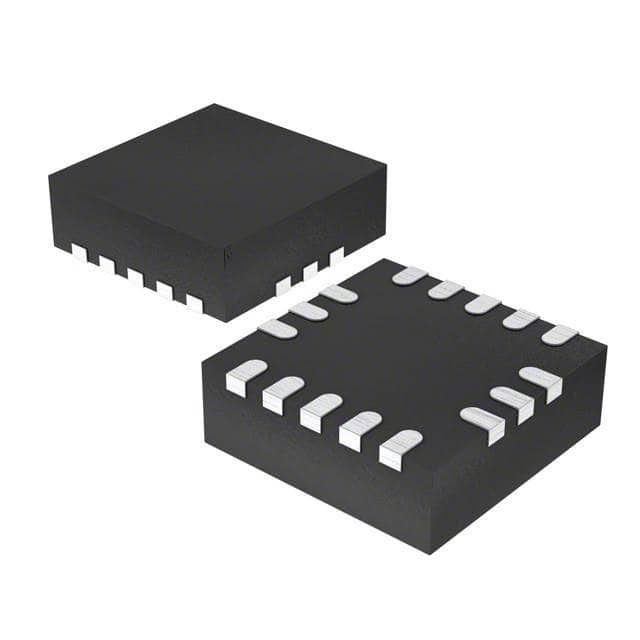LIS3DSHTR
Product Overview
The LIS3DSHTR is a high-performance three-axis linear accelerometer belonging to the MEMS digital output motion sensor family. This sensor is widely used in various applications due to its small package size, low power consumption, and high resolution.
Category
MEMS Digital Output Motion Sensor
Use
The LIS3DSHTR is used for motion sensing and orientation detection in a wide range of applications including consumer electronics, automotive, industrial, and medical devices.
Characteristics
- Small package size
- Low power consumption
- High resolution
- Digital output
- Three-axis linear acceleration measurement
Package
The LIS3DSHTR is available in a small, lead-free, 16-lead LGA package.
Essence
The essence of the LIS3DSHTR lies in its ability to accurately measure three-axis linear acceleration and provide digital output for motion sensing applications.
Packaging/Quantity
The sensor is typically available in tape and reel packaging with a quantity of 2500 units per reel.
Specifications
- Operating Voltage: 2.16V to 3.6V
- Full Scale Range: ±2g / ±4g / ±6g / ±8g / ±16g
- Output Data Rate: 1.6 Hz to 5.3 kHz
- Interface: I2C/SPI
Detailed Pin Configuration
The LIS3DSHTR features a 16-pin LGA package with the following pin configuration:
- SCL/SDI (Serial Clock/Data Input)
- SDA/SDO (Serial Data/Slave Data Out)
- CS (Chip Select)
- SA0 (I2C Address Selection)
- GND (Ground)
- VDD (Power Supply)
- INT1 (Interrupt 1)
- INT2 (Interrupt 2)
- NC (No Connection)
- XOUT (X-Axis Output)
- YOUT (Y-Axis Output)
- ZOUT (Z-Axis Output)
- GND (Ground)
- VDD (Power Supply)
- NC (No Connection)
- NC (No Connection)
Functional Features
- Three-axis linear acceleration measurement
- Digital output
- Low power consumption
- Embedded temperature sensor
- Self-test capability
- FIFO buffer for reducing system power consumption
Advantages and Disadvantages
Advantages
- Small package size
- High resolution
- Wide operating voltage range
- Low power consumption
- Digital output for easy interfacing
Disadvantages
- Limited full-scale range options
- Sensitivity to external magnetic fields
Working Principles
The LIS3DSHTR operates based on the principles of micro-electromechanical systems (MEMS) technology. It utilizes capacitive sensing elements to measure acceleration along the X, Y, and Z axes. The measured capacitance changes are converted into digital signals and processed to provide accurate acceleration data.
Detailed Application Field Plans
The LIS3DSHTR finds extensive use in various application fields, including: - Consumer Electronics: Mobile phones, tablets, gaming devices - Automotive: Advanced driver assistance systems, vehicle stability control - Industrial: Condition monitoring, vibration analysis - Medical Devices: Patient monitoring, fall detection systems
Detailed and Complete Alternative Models
Some alternative models to the LIS3DSHTR include: - LIS2DH12: A two-axis digital output accelerometer with similar characteristics - ADXL345: A three-axis digital output accelerometer with different package options - MPU-6050: A six-axis motion tracking device with integrated gyroscope
In conclusion, the LIS3DSHTR is a versatile and reliable three-axis linear accelerometer that caters to a wide range of motion sensing and orientation detection applications across various industries.
[Word Count: 587]
قم بإدراج 10 أسئلة وإجابات شائعة تتعلق بتطبيق LIS3DSHTR في الحلول التقنية
What is LIS3DSHTR?
- LIS3DSHTR is a high-performance three-axis linear accelerometer designed for industrial applications.
What are the key features of LIS3DSHTR?
- The key features include ultra-low power consumption, high resolution (16-bit), and a wide range of full-scale acceleration measurement from ±2g to ±16g.
How is LIS3DSHTR typically used in technical solutions?
- LIS3DSHTR is commonly used for vibration monitoring, tilt sensing, and motion detection in industrial equipment, structural health monitoring, and wearable devices.
What are the communication interfaces supported by LIS3DSHTR?
- LIS3DSHTR supports I2C and SPI digital interfaces for communication with microcontrollers or other devices.
Can LIS3DSHTR be used in harsh environments?
- Yes, LIS3DSHTR is designed to operate in harsh environments and can withstand mechanical shocks and vibrations.
What is the operating voltage range of LIS3DSHTR?
- The operating voltage range is typically 2.16V to 3.6V.
Does LIS3DSHTR have built-in self-test capability?
- Yes, LIS3DSHTR includes a self-test function to verify the functionality of the sensor.
Is there any specific calibration required for LIS3DSHTR?
- Calibration is typically not required for LIS3DSHTR as it comes factory-calibrated.
What are the typical power consumption characteristics of LIS3DSHTR?
- The power consumption is very low, making it suitable for battery-powered applications. It typically consumes less than 10μA in low-power mode.
Are there any known limitations or considerations when using LIS3DSHTR in technical solutions?
- Users should consider the temperature range, sensitivity to electromagnetic interference, and proper mounting and handling to ensure accurate and reliable measurements.


